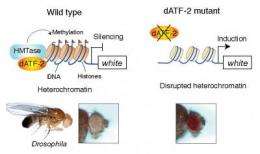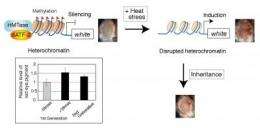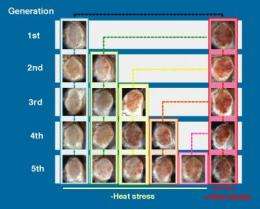Mechanism for stress-induced epigenetic inheritance uncovered in new study

Researchers at RIKEN have uncovered a mechanism by which the effects of stress in the fly species Drosophila are inherited epigenetically over many generations through changes to the structure of chromatin, the material that makes up the cell nucleus. Published in the journal Cell, the results highlight the role of the transcription factor dATF-2 in chromatin assembly, marking a major advance in our understanding of non-Mendelian inheritance.
Recent years have seen growing interest in the phenomenon of epigenetic inheritance: the idea that our genome, through epigenetic tags and other structural modifications, transmits more information than the sequence of letters encoded in its DNA base pairs alone. Stresses of various kinds have been shown to induce such epigenetic change, yet the underlying mechanisms involved remain unknown.

To clarify these mechanisms, the researchers investigated the activity of activation transcription factor-2 (ATF-2), a member of a family of transcription factors which regulate gene expression in response to changes in the cellular environment. Earlier research had suggested that in the absence of stress, ATF-2 plays a role in silencing certain genes through the formation of heterochromatin, a tightly-packed variety of chromatin whose state is epigenetically heritable. When the stress is turned on, ATF-2 changes its function and induces gene expression.
Studying mutations to the ATF-2 gene in Drosophila (dATF-2), the researchers observed a disruption to the heterochromatin structure and reduced methylation of histone proteins, the main component of chromatin (Fig. 1). Further analysis revealed that heat shock and osmotic stress during early embryogenesis results in phosphorylation of dATF-2 and triggers its release from the heterochromatin.

Most interestingly, the researchers discovered that the disruption to heterochromatin caused by the release of dATF-2 was transmitted to the next generation of cells, without any change to their DNA sequences (Fig. 2). In the case of heat shock, sustained stress over multiple generations resulted in the altered chromatin state being inherited by subsequent generations as well (Fig. 3). The findings thus provide the first example of multigenerational transmission of stress-induced epigenetic change, highlighting the role played by ATF-2 and opening promising new avenues for further study.
Provided by RIKEN


















